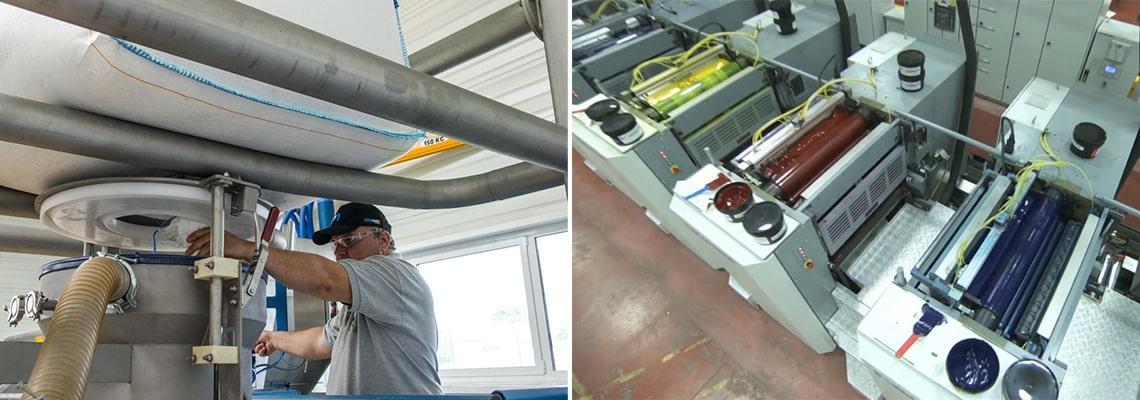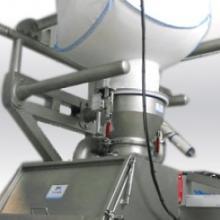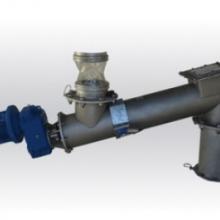Materials: TiO2 (Titanium Dioxide)
Industrial Equipment for Feeding a Solvent Reactor in ATEX zone
The objective: Our client, located in the suburbs of Cincinnati, OH, is a global manufacturer of high-performance printing inks and coatings for commercial, packaging, and digital print applications. Their facility received TiO2 in big bags and required a means of safely unloading the material and conveying the powder to an industrial solvent’s reactor. The industrial area was classified for NFPA classification 1 / division 2, which required all electronic components to be explosion proof.
What is TiO2? Titanium dioxide, also known as titanium (IV) oxide or titania, is the inorganic compound with the chemical formula TiO2. When used as a pigment, it is called titanium white, Pigment White 6 (PW6), or CI 77891. It is a white, water-insoluble solid, although mineral forms can appear black. As a pigment, it has a wide range of applications, including paint, sunscreen, and food coloring.
What is the NFPA? The National Fire Protection Association is an international nonprofit organization devoted to eliminating death, injury, property and economic loss due to fire, electrical and related hazards. The National Electric Code (NEC) or NFPA 70 defines hazardous locations as those areas where fire or explosion hazards may exist due to flammable gases or vapors, flammable liquids, combustible dust, or ignitable fibers or flyings.
The solution: Our team of powder handling experts designed a solution that would allow the unloading of big bags via an electrical hoist and discharge the bulk solids into a screw conveyor for extraction and reactor feeding. All motors and electrical components were rated to meet Class 1/Div 2 explosion rated standards.
The Industrial Equipment:
- The Duopal®DP1 Big Bag and Sack Unloading Station
- Tubular Screw Conveyor
- Explosion Proof Control Panel
1. The Duopal®DP1 Big Bag and Sack Unloading Station
The first part of this industrial installation centered around a station that would allow the emptying and discharging of bulk materials from 1-ton super sacks and 22 kg paper bags. The height of the installation was restrictive; therefore, our team of industrial engineers designed a solution that allowed a low-height structure for installation on the client’s second floor mezzanine. By combining the functions of both a sack tip tray / bag dump station for 22 kg sacks into the same footprint of a big bag unloader, a considerable floor space was saved. An electrical hoist was installed directly onto a support rafter that was validated and designed to handle the extra load of lifting and transferring 1 ton big bags. With these established features, the client was able to fit the powder handling equipment within their confined work area.
Manufacturer’s who handle TiO2 know all to well that this powder tends to have poor flow characteristics. The powder tends to cling to itself, clumping up causing bridging and rat-holing issues over discharge outlets of hoppers, silos and IBCs. Our powder processing team took further steps to remedy any potential flow issues coming out of the super sack. One such feature is a telescoping flexible discharge chute with a clamping connection plate. By clamping the big bag’s outlet spout, the telescoping tube can provide a minimal downward pulling action to help stretch the spout and cause a funneling effect on the bottom corners of the big bag. This downward pulling action helps create a sloping angle on the bottom side of the FIBC to further promote the flow of the clumping powder. Furthermore, massage paddles are built into the bottom corners of the big bag tray. These paddles are attached to pneumatic actuators and can lift and squeeze the bottom corners of the big bag. This action can help break up material bridging to further promote the flow of the bulk powder.
Underneath this spout clamping plate is a built-in bag dump station. Also called sack tip trays, this unit contains a safety grid that allows an operator to place an entire 20– 50 kg paper sack of TiO2 inside the cabinet. The operator then can use his utlitity knife, secured to the inside of the cabinet, to cut open the bag and pour out the contents.
2. Tubular Screw Conveyor
In order to transfer the TiO2 powder from the super sack emptying station to the main solvent reactor, our team employed the use of a mechanical auger conveyor, also called a screw conveyor. This industrial machine is responsible for the powder transfer to the downstream production process. This type of powder conveying equipment is excellent for both the transfer of and controlled metering of bulk solids and dry materials. The inlet is bolted to the bottom flange of the big bag hopper and consists of a direct drive motor attached to a tubular housing. Inside the tube is an auger with spiral flights which cause the forward momentum of the powder and bulk solids. It is designed to handle a throughput rate of 8,200 kg/hr. The length between the inlet and outlet is approximately 60” with a tube diameter of 11”.
Screw conveyors are great for continuous powder feeding applications with their robust design that allows them to work with light, medium or heavy-duty industrial applications. Because of its mechanical agitation technique, auger conveyors are also well suited for powders that tend to clump and have poor flow properties.
3. Explosion Proof Control Panel
When designing a control panel for a NEC NFPA 70 rated hazardous area is to first see if it is possible to install it outside the zone or room. If not, the next step is to explore options for either air purge or pressurized cabinet methods, or, a 10-bar rated bolted panel.
For this project, we used a Ex control panel designed and built to operate in environments where concentrations of flammable gases, vapors, liquids or combustible particles pose risks of ignition and explosion. The explosion proof control panel enclosures are cast from heavy duty aluminum so that they cannot create a spark that could possibly ignite the vapors in a hazardous location. These heavy-duty panels come with seals to keep explosive fumes from entering the control panel. Also, the explosion proof control panels are designed to contain an internal explosion without igniting the explosive vapors present in the hazardous area to make sure it is safe for the hazardous classification 1 / division 2 zone. Explosion proof panels are built with robust metal walls to allow the containment of internal explosions from components and the sustainment of external explosions. Fittings, glands, and other system components will be ensured to have the appropriate rating for the hazardous area standards
















